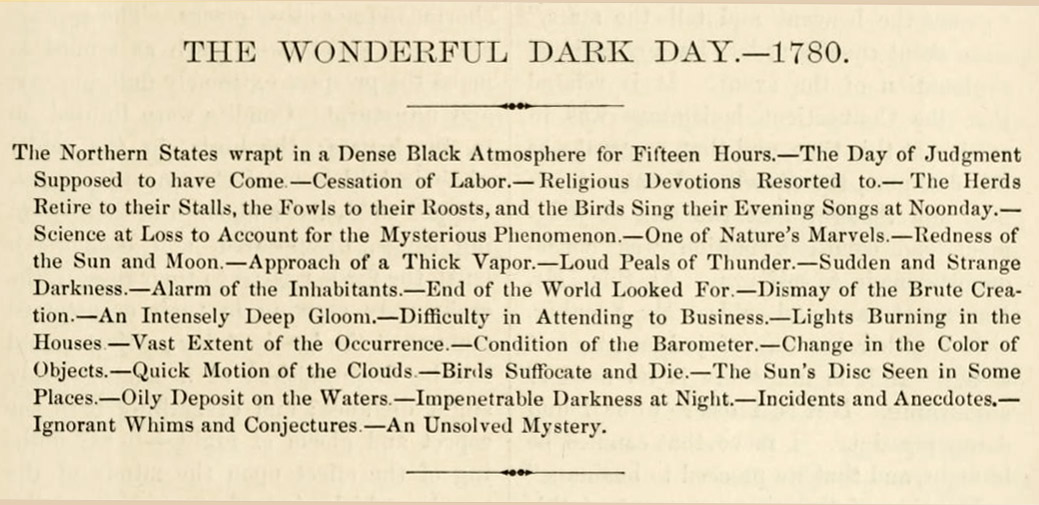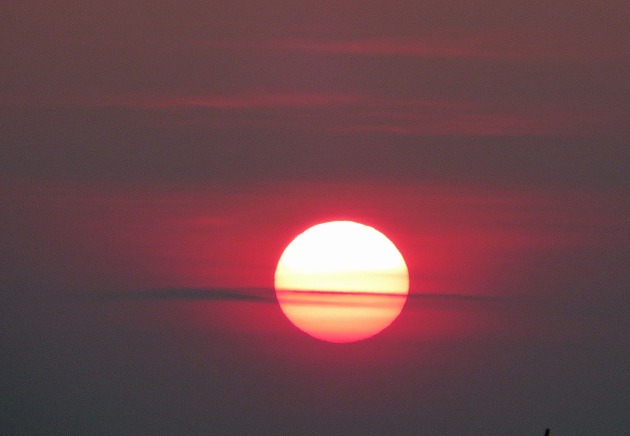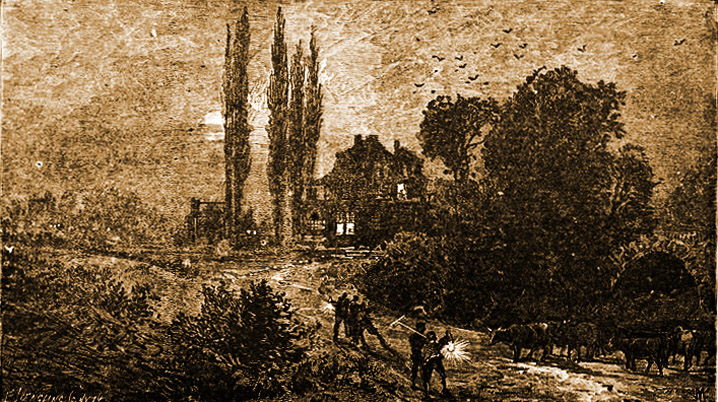On the afternoon of May 18, 1780, the sky was a strange yellowish color and the clouds seemed dark and heavy. The next morning the sun came up deep red and barely visible through a haze, until by noon there was “midnight darkness” and people could not see. Candles were lighted, cattle lowed, and fowls went to roost. Men returned from their labor in the fields. The darkness stretched south from the Canadian border, covering most of Vermont, Connecticut, New Hampshire, and Massachusetts. Samuel Tenney noted that, “the darkness was most gross in the county of Essex, the lower part of the state of New-Hampshire and the old Province of Maine.”
At 2:00 pm in Ipswich roosters crowed and frogs peeped as if darkness had fallen. A witness reported that a strong sooty smell prevailed in the atmosphere, and a dark sooty rain began to fall, full of burnt leaves and ash. The first half of the night was hideously dark, and no ray of light from moon or star could penetrate the darkness until after midnight when a blood-red moon emerged. By the next morning, dark ash lay along the banks of the Merrimack River in Newburyport, four or five inches thick.
The Boston Independent Chronicle proclaimed “a portentous omen of the wrath of Heaven in vengeance denounced against the land … the immediate harbinger of the last day, when the sun shall be darkened, and the moon shall not give her light.” An alarmed Boston resident sent her servant in the midst of the darkness to ask the local minister whether he thought the blackened skies portended some coming evil. The minister glibly responded, “Give my respectful compliments to your mistress, and tell her I am as much in the dark as she is.”

In 1878, Richard M. Devins wrote about the Dark Day in “Our first century: being a popular descriptive portraiture of the one hundred great and memorable events of perpetual interest in the history of our country“:
“Almost, if not altogether alone, as the most mysterious and as yet unexplained phenomenon of its kind, in nature’s diversified range of events, during the last century, stands the Dark Dark of May Nineteenth, 1780, a most unaccountable darkening of the whole visible heavens and atmosphere in New England, which brought intense alarm and distress to multitudes of minds, as well as dismay to the brute creation, the fowls fleeing, bewildered, to their roosts, and the birds to their nests, and the cattle returning to their stalls.
“Indeed, thousands of the good people of that day became fully convinced that the end of all things terrestrial had come; many gave up, for the time, their secular pursuits, and betook themselves to religious devotions; while many others regarded the darkness as not only a token of God’s indignation against the various iniquities and abominations of the age, but also as an omen of some future destruction that might overwhelm the land, as in the case of the countries mentioned in biblical history, unless speedy repentance and reformation took place. The ignorant indulged in vague and wild conjectures as to the cause of the phenomenon; and those profounder minds, even, that could “gauge the heavens and tell the stars,” were about equally at loss for any rational explanation of the event.
“The time of the commencement of this extraordinary darkness was between the hours of ten and eleven in the forenoon of Friday, of the date already named; and it continued until the middle of the following night, but with different appearances at different places. As to the manner of its approach, it seemed to appear first of all in the southwest. The wind came from that quarter, and the darkness appeared to come on with the clouds that came in that direction.
“The degree to which the darkness arose varied in different localities. In most parts, it became so dense, that people were unable to read common print distinctly, or accurately determine the time of day by their clocks or watches, or dine, or manage their domestic affairs conveniently, without the light of candles. In some places, the degree of darkness was just about equal to preventing persons seeing to read ordinary print in the open air, for several hours together.
“With regard to its duration, it continued in the neighborhood of Boston for at least fourteen or fifteen hours; but it was doubtless longer or shorter in some other places. The appearance and effects were such as tended to make the prospect extremely dull, gloomy, and unnatural. Candles were lighted up in the houses; the birds, in the midst of their blithesome forenoon enjoyments, stopped suddenly, and, singing their evening songs, disappeared, and became silent; the fowls retired to their roosts; the cocks were crowing in their accustomed manner at the break of day; objects could not be distinguished at a comparatively slight distance; and everything bore the aspect and gloom of night, to say nothing of the effect upon the minds of the people, which, indeed, was quite indescribable.”

The cause of the Dark Day of 1780 would remain elusive for more than a century. Researchers examining old burn damages to trees in Ontario attribute the Dark Day to a major fire in the area that is now the Algonquin Provincial Park. In the 19th century, the logging industry harvested great swaths of large white pine and red pine trees to produce lumber for domestic and American markets. Based on observations of wind direction and barometric readings it has been determined that a low pressure weather system carried dense smoke to New England.

Sources and further reading:
- Devens, Richard Miller: Our first century: being a popular descriptive portraiture of the one hundred great and memorable events of perpetual interest in the history of our country
- Barry, John Stetson: The History of Massachusetts: The Dark Day
- New England’s Dark Day
- What Caused New England’s Dark Day?
- International Journal of Wildland Fire: Fire scars reveal source of New England’s 1780 Dark Day


eye witnesses stated it was a full moon and the stars were visible.The darkness was so complete you couldn’t see your hand in front of your face.